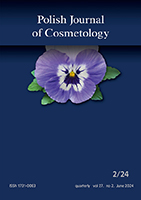search by
Copyright @ Pol J CosmetolParabens as preservatives in cosmetic productsMateusz Pawłusiewicz, Agata Łącka Instytut Chemii Podstaw Żywności, Zespół Chemii Bionieorganicznej, Wydział Biotechnologii i Nauk o Żywności, Politechnika Łódzka Summary Introduction. Parabens are the most commonly used preservatives in cosmetics, unfortunately, consumers are reluctant to receive cosmetic products despite the fact that these compounds are the best-studied group of preservatives that I use in cosmetics. Aim. Aim of this work was to determine the content of preservatives, which were parabens in selected types of cosmetic products. Material and methods. The study included randomly selected 14 cosmetic products with the presence of three methyl-, ethyl- and propylparaben paraben pairs declared by the producer to determine their specific cosmetic content. Results. All analyzed parabens: methylparaben (MP), ethylparaben (EP) and propylparaben (PP) absorb electromagnetic radiation in the UV range, with a maximum absorption of 254 nm. Chromatographic separation was obtained on a Hypersil BDS 150x4.6 column, with a mobile phase having a composition of acetonitrile: 60:40 (v/v) water, with an isocratic flow of 1 ml/min. Under such conditions, a good separation of the three parabens was observed and retention time of particular peaks was 2.17 (MP), 2.36 (EP) and 2.65 (PP) minutes. Samples in the leave-on cosmetics group contain less total parabens (46.2-264.1 mg / 100 g) than rinse off (211.9-588.7 mg / 100 g). The exception was sample 14, containing three marked parabens (total of 8.8 mg/100 g) and declared by the producer to be paraben free. Conclusions. The resulting paraben content does not exceed the allowable amount of parabens or mixtures thereof in the cosmetic formulation. Key words: parabens, high performance liquid chromatography, UV spectrophotometry |




